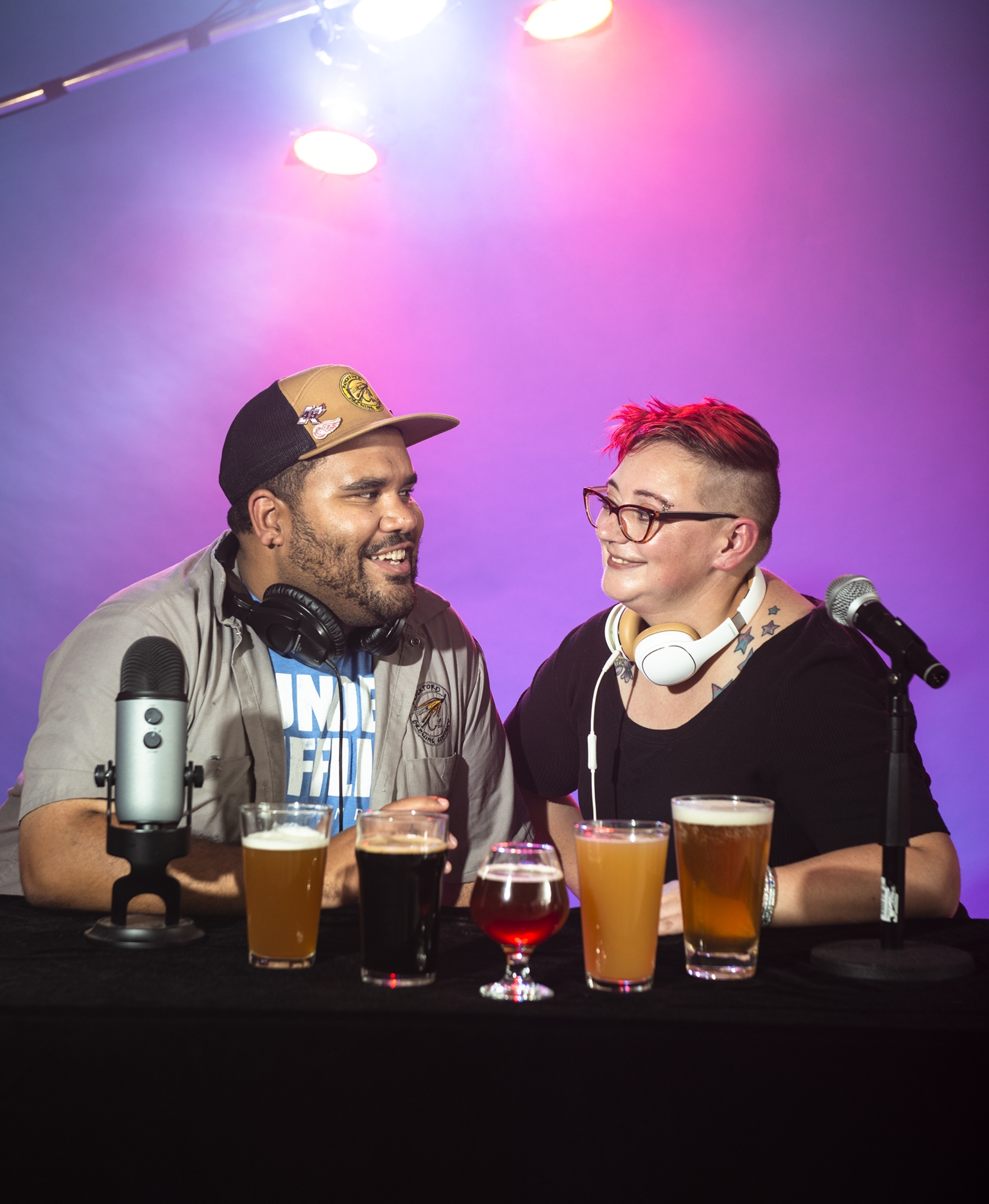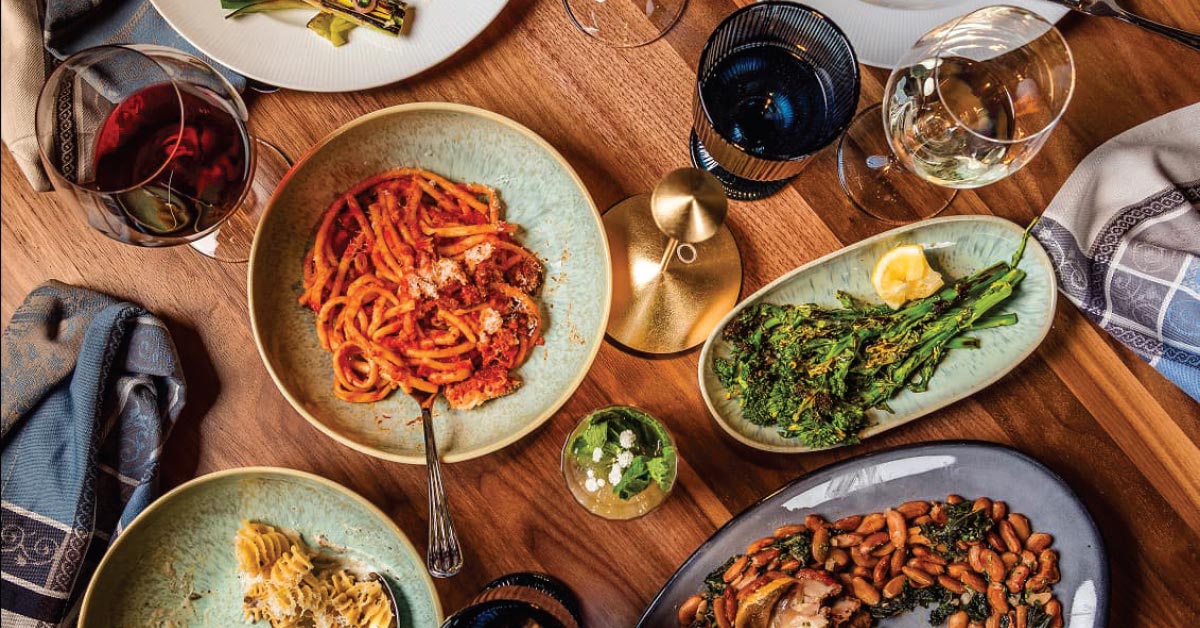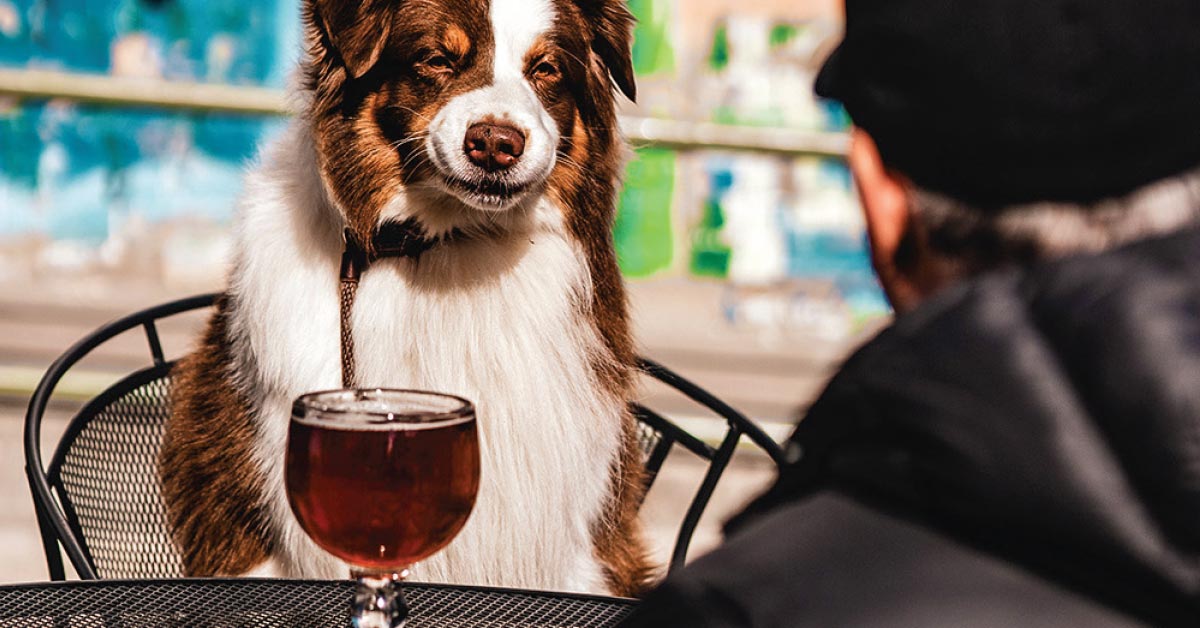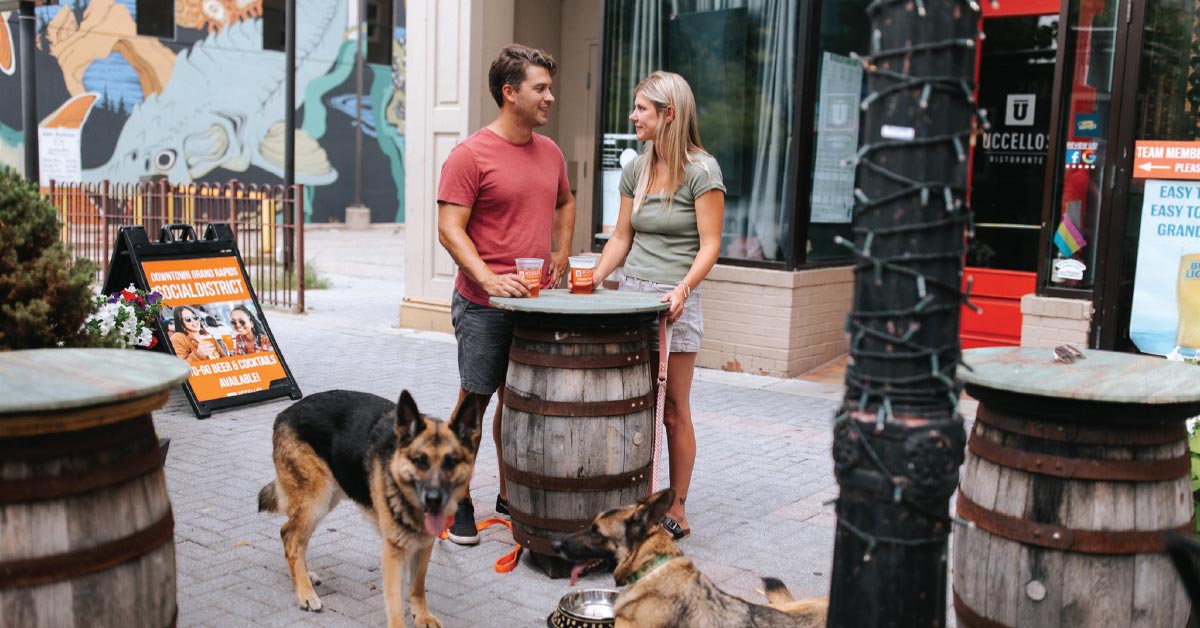There’s this theory, The Six Degrees of Kevin Bacon, that supposes every person on Earth is six or fewer acquaintances away from Kevin Bacon. For example, if your dogwalker’s cousin’s dad was a gaffer on the set of Footloose — boom — you’re four degrees from Bacon. It’s a goofy theory, but it’s one that posits this large world is actually small and our relationships cast a wider influence than we know. For those with even a toe in Grand Rapids’ beer scene, the steps separating you and the hosts of In MI Pint, Kati Spayde and Ben Darcie, are unquestionably less.
If you’ve shopped at Siciliano’s in the past 13 years, I guarantee Spayde has guided you through the shelves to a beer that made you happy. As the store’s resident beer buyer, her palate is unmatched and she has a keen eye for distributor shenanigans. I’d trust no one else to stock the beer fridge in heaven.
And Darcie, well, he seems to be everywhere at once. While currently a sales rep for Rockford Brewing Company, his CV includes stints as wandering monk at Brewery Vivant, assistant manager/brew school teacher at Gravel Bottom, and beer editor at this very magazine. Let’s not forget his self-started education company, Experience Beer. Yeah, the dude loves beer.
Both of the hosts do, and their passions shine together in their podcast, In MI Pint. While plenty of beer journalism devolves into disposable listicles and reviews (both of which I’m guilty of), Kati Spayde and Ben Darcie dig into meat, such as a three-part series discussing the intricacies of distribution law. If that sounds dry, let me assure you it’s anything but, thanks to the hosts’ chemistry and pointed interview questions. They’re generous with their knowledge yet hungry to learn more — the perfect duo to corral information from their on-air guests to the listener's ear.
Revue met up with the podcasters to talk shop with those who do so best. Hot takes and wisdom abound — here’s what we learned about the state of beer in 2019.
This interview has been edited for length and clarity.
So, how did you two meet?
Kati Spayde: We met through Siciliano’s. Ben and his friends would come in, buy tobacco and check out all the beer. You can’t miss Ben.
Ben Darcie: It’s true. We were mildly obsessed with Siciliano’s for years, but we couldn’t buy beer, so we’d just go three or four times a week to buy cigars and drool all over the beer.
KS: You were very forthright about the fact you weren’t 21 yet. It was actually pretty nice.
When did you decide it was time to start a podcast?
KS: We started August of 2018, but Ben had been texting me for months beforehand trying to get me on board. You wanted someone who matched your geekiness.
BD: If I was going to be a host, one of the things I definitely wanted was a knowledgeable co-host. It was also very important for me to have equal representation between genders for a beer show, because there’s not nearly enough amazing women heard in the beer industry right now.
KS: We’re getting there. But it’s been a long, painful road for some of us. It was nice that you were even aware of that.
Who have been some of your favorite guests?
KS: Mitch Ermatinger from Speciation. That was fun. That boy can talk. Also, being the law and legislation geek that I am, I liked talking with everyone who works on the distribution end, just to hear all the weird technicalities that you don’t know as a general beer drinker.
BD: That’s one of the underlying themes of the show. We should talk about topics that are relevant and important that people should know about, but don’t talk about.
What are some of these conversations in the beer community that should be addressed but aren’t?
KS: I think that quality control needs to be something people talk about again. About eight or nine years ago, there was a huge influx of new breweries doing crazy beers. There were quality control issues and everyone said, “All right, we need to buckle down and get this under control.” And things got really good! But I’m starting to see that same pattern again. There’s an enthusiasm that’s unfortunately not backed up by quality control and I wish people would call that out.
BD: I think one of the more practical things I wish people would understand is cost. People like to complain about a $20 six-pack without understanding how the three-tier system works. It’s a dangerous “I know everything” mentality.
KS: Big box stores are devaluing the whole market by selling beer for pennies on the dollar. It’s bringing down people’s perceived value of beer when they show up to an independent bottle shop that’s not selling 2,000 square feet of groceries to make their money. There’s this whole idea that big box stores are buying things in bulk and getting bulk pricing when really, we’re all buying it for the same price. I’m sorry, but we have to keep the lights on. We can’t sell things for 2 cents over cost.
Regarding relationships with the consumer, how does a brewery satisfy the market’s demands without sacrificing their identity?
KS: I think breweries need to be confident in their brands. Look at Founders. “We’re gonna put out a goddamn pilsner and you’re gonna like it.”
BD: But you have to have the brand power to do that. If you’re a tiny brewery, you don’t have that power. I think it comes down to being proactive versus reactive. Generally, the industry is reactive, like, “Oh Brut IPA is really popular, we should make a Brut IPA!” Reactive. Then you see Old Nation years ago going, “Hey, New Englands are becoming a big thing, maybe we should put some eggs in this basket.” Now they’re the Kleenex of New England IPA. Proactive.
What do you think separates “fad” styles from the styles that stick?
KS: People ask me all the time, “What’s the next big thing in beer?” If I knew that, I would be a millionaire right now. Other than just saying IPAs and sours, it’s really hard trying to guess what consumers will latch onto next. For 20 minutes, milkshake IPAs were everything.
BD: I feel like it’s all shots in the dark. In the Midwest, we’re listening to the East and West to see what’s rummaging around, but what’s left?
KS: It’s hard right now to balance your inventory based on what’s classic and will sell and what crazy random things should I bring in. Here’s a sour with black sea salt, guava and cumin. How about an IPA with pineapple and szechuan sauce. You definitely want to have those super weird beers because they’re fun and people like to try them, but how much do we want to gamble on them?
During your time in Grand Rapids, have you seen tastes change or evolve?
BD: The biggest thing I’ve learned is that the demographic of people we’re selling beer to is incessantly distractible. My grandad drank Miller Lite, my dad drank Stroh’s, and then I drink everything. And then we think about the age beneath us who can find anything they want at any time. They are the furthest thing from a Miller drinker. They want everything new, everything interesting, and that’s when you end up seeing these reactive moves by breweries because they’re trying to remain relevant.
KS: The biggest change I’ve seen is the sheer volume of beer available. It’s insane. Michigan is always, always expanding, which is great — we live here and we have friends who work at breweries — but the problem is it’s such an oversaturated market in Michigan, to the point where we’re excluding the rest of the country. We’re becoming isolationists.
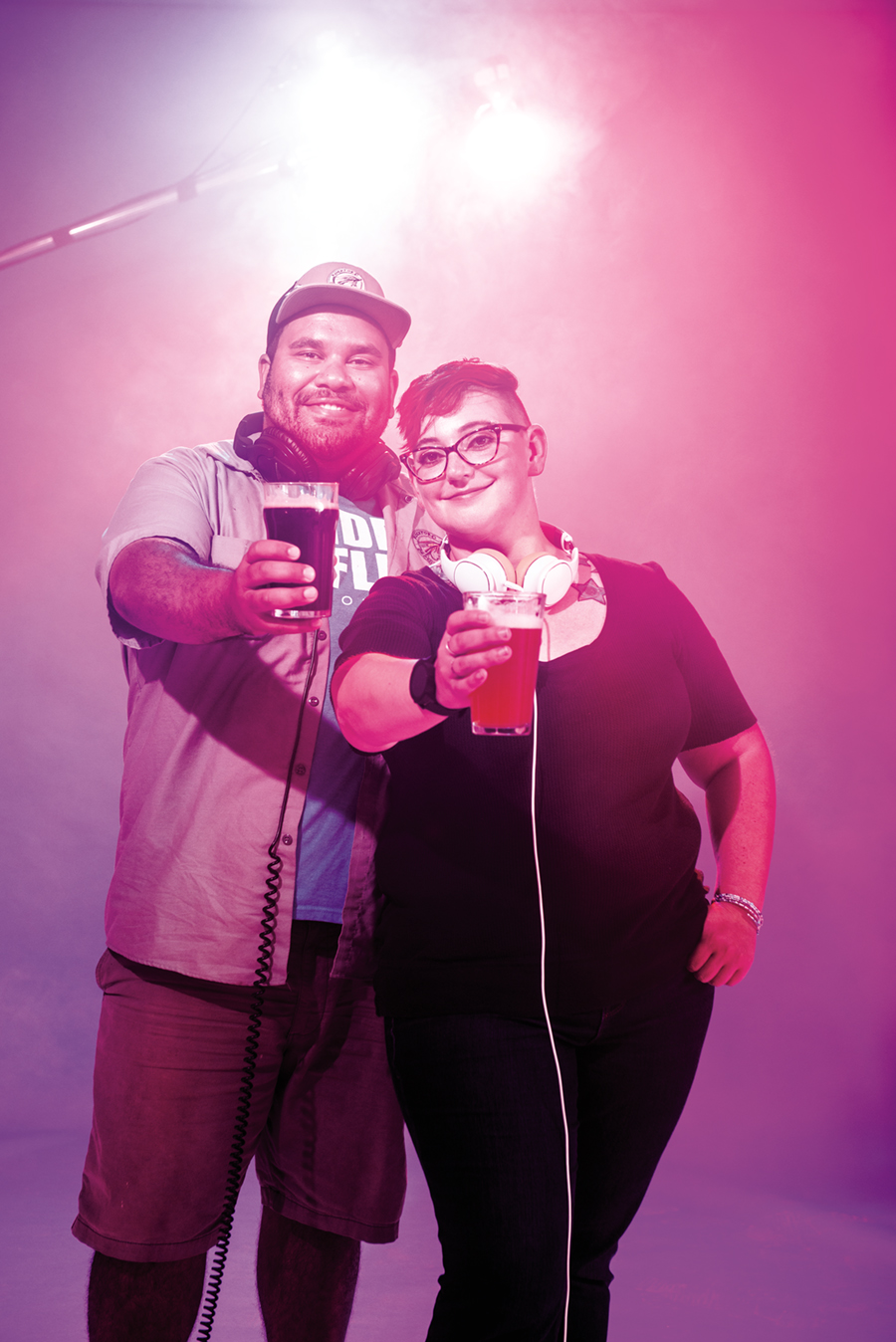
Regionally, we’re seeing Michigan breweries struggle with growth as well. I’m left wondering what the perfect model is to ensure a brewery’s survival in 2019.
KS: I think people need to realize there’s not going to be another Bell’s or Founders in Michigan. You don’t have to be 100-percent growing all the time to be successful. Be happy being mid-range, or be happy being a neighborhood pub. I have a neighborhood pub; it’s the best. The big craft beer boom had too many expectations out there, to the point where every new brewer thought they’d become a millionaire.
BD: When Perrin opened, they said specifically, they’re going to be the next Founders. You see what happens when somebody very specifically goes for that with the money, the space and at the relatively right time. They landed right and they’re doing very, very well, but still I’m thinking neighborhood pubs are the way to go. Distribution is jogging uphill on a steep incline unless you have a whole bunch of volume.
With the purchase of many high-profile breweries muddying the definition of “craft,” how important do you think independence is in beer right now?
BD: I have a kind of pessimistic view on this topic. The beer industry’s memory is alarmingly short. Scandals happen all the time and people get upset about them for three days on the internet and then completely forget about it.
KS: The last time people really had a problem with a brewery getting bought out was with Goose Island, and that was probably because it was the first of its kin. But inadvertently, they proved you can be bought by a large company and still produce quality beer. Nobody cares that Goose Island got bought out when Black Friday comes around and everyone wants Bourbon County Stout. From a buyer’s perspective, as long as the quality stays fine, I don’t really care. That said, I prefer when smaller breweries team up, like Right Brain and ROAK. If you can’t both survive on your own, why not combine forces?
BD: I’m anticipating seeing more of that as we see independent brewers work together.
It seems like craft has taken a page from Big Beer’s playbook, investing in seltzers and other beer alternatives. Do you think that’s a sign of craft losing touch with its integrity, or just trying to be proactive to consumer taste?
KS: Personally, do I drink seltzers? No. Am I mad that people are making seltzers? No. I do wish that not every brewery was trying to bring one to market. Have it on tap, awesome. You need to have diversification to bring people into the taproom.
BD: I think seltzers have taken the industry by storm so fast there was nothing to do but react. I don’t get mad when breweries make a seltzer. The brewing culture has a really nasty tendency of putting a rift right down the middle and you’re either on the right or the left. Especially all the old-timey brewers from the ’90s, you should have heard the discussions when New Englands came around.
Looking ahead, what topics can listeners expect in future episodes of the podcast?
BD: Detroit Fall Beer Fest. We’re trying to get down into the gypsum mines for an episode. Guest episodes are always super fun. We’ve always talked about doing a drunk episode where we just get really, really drunk and talk about food pairings.
KS: What do you eat when you’re really drunk? We haven’t been brave enough to do it yet.
BD: I hope we’re not annoying when we’re drunk...


